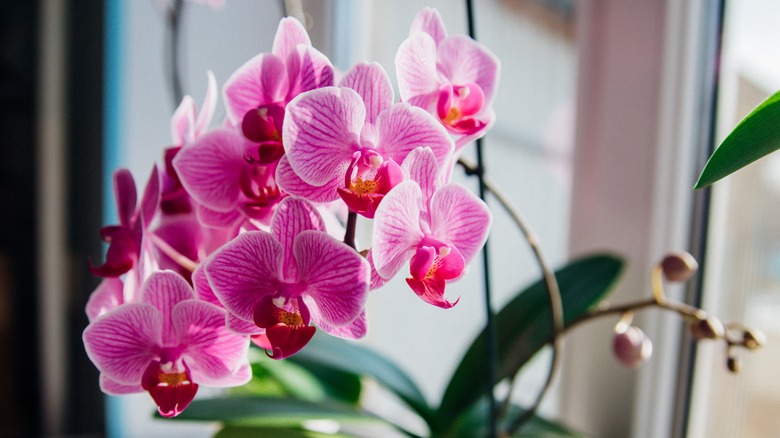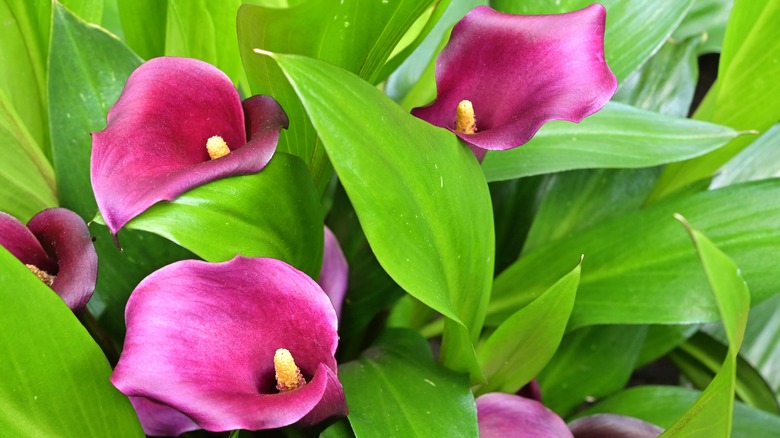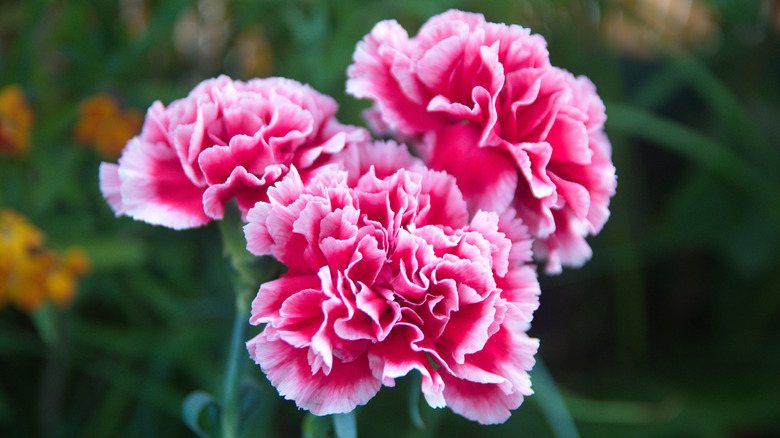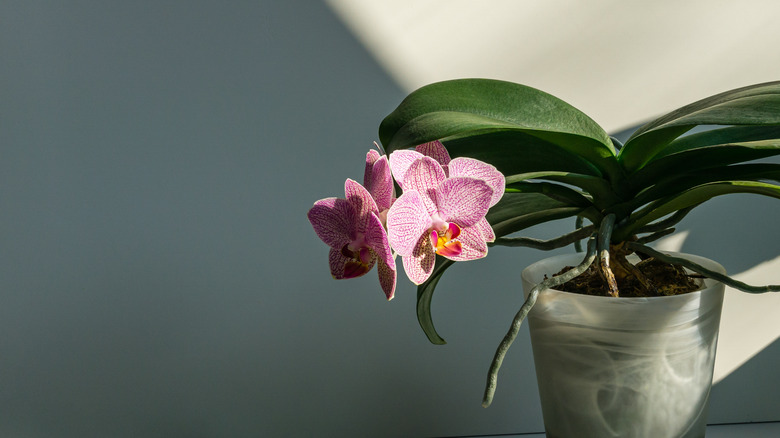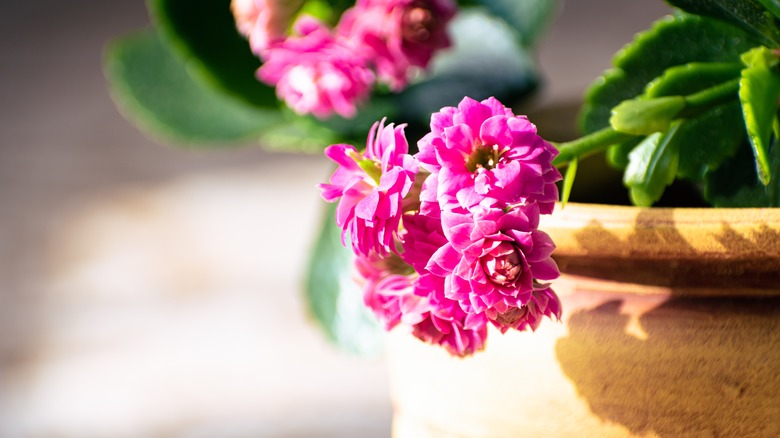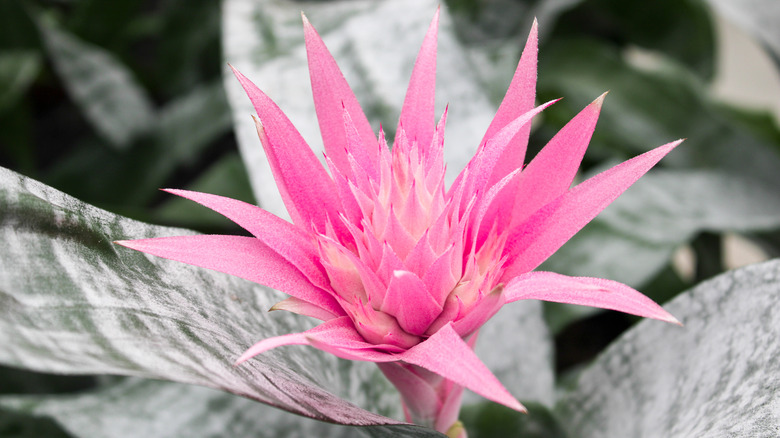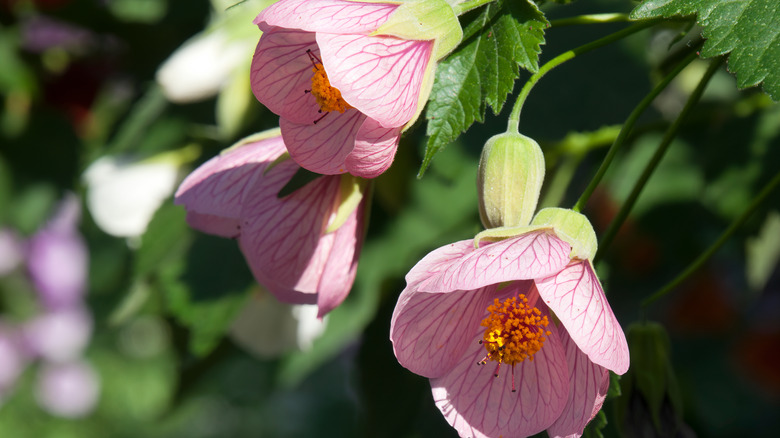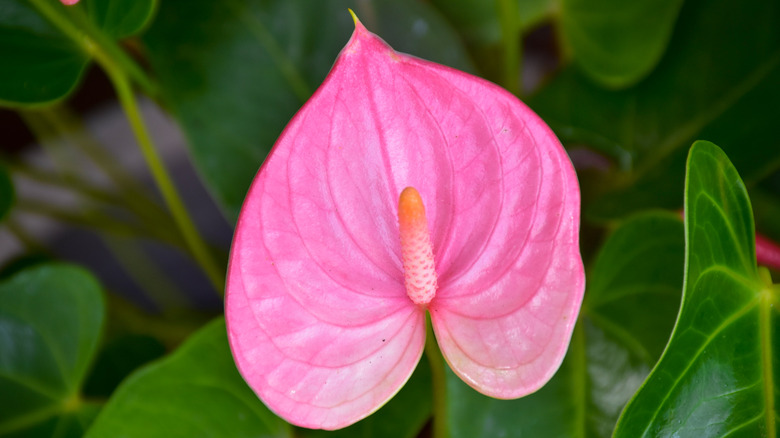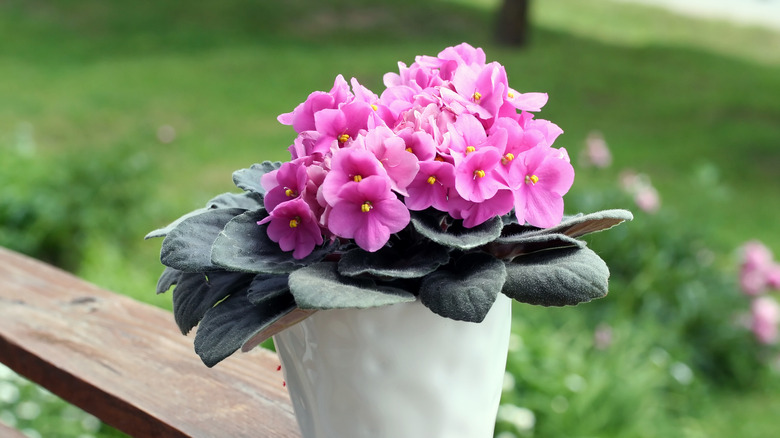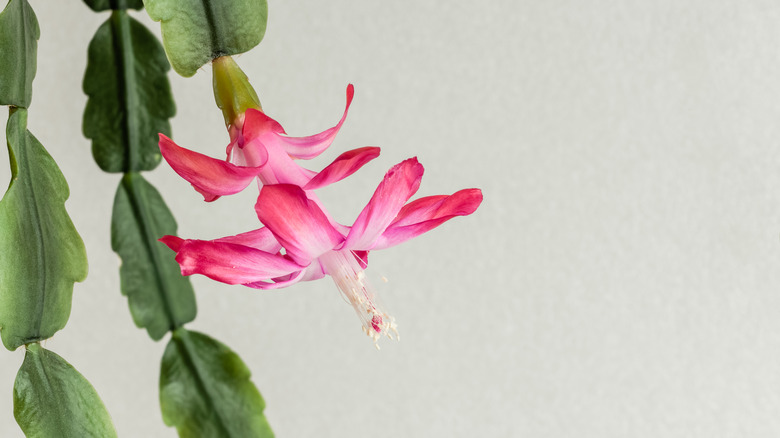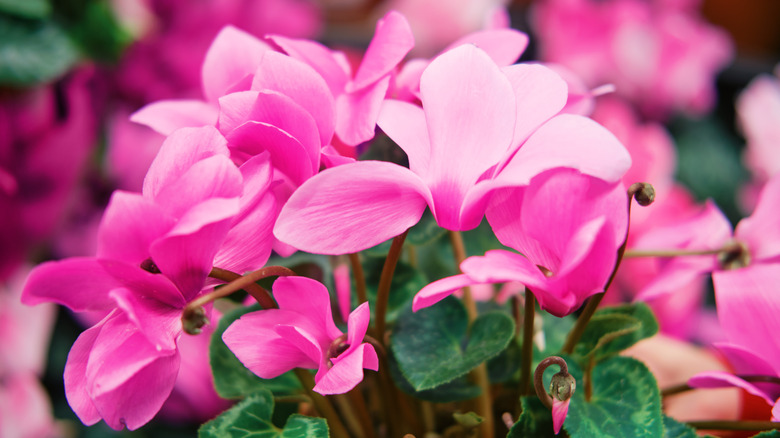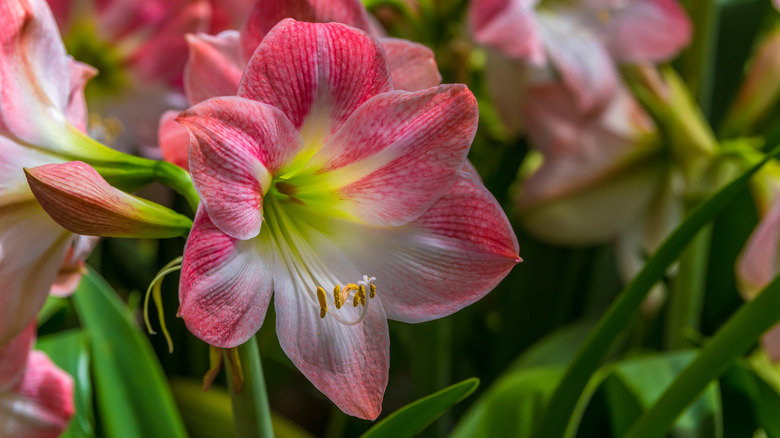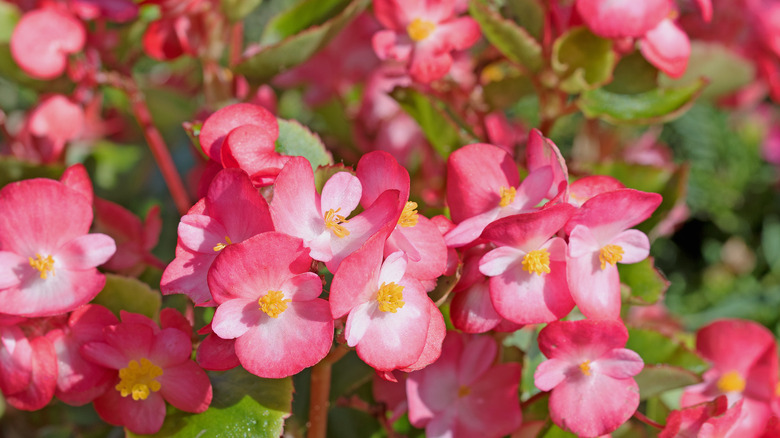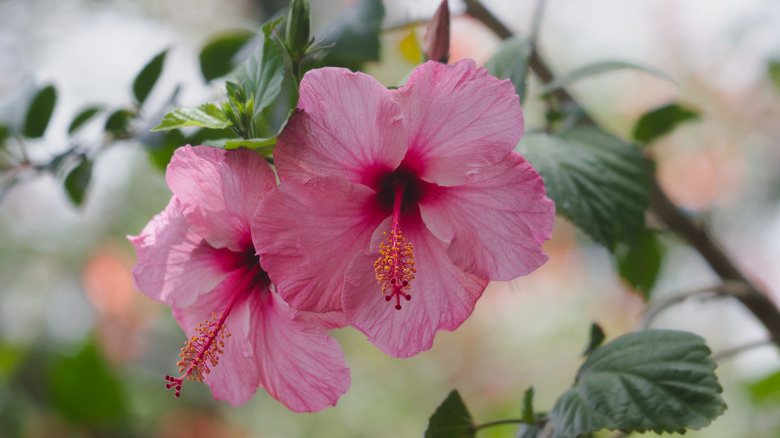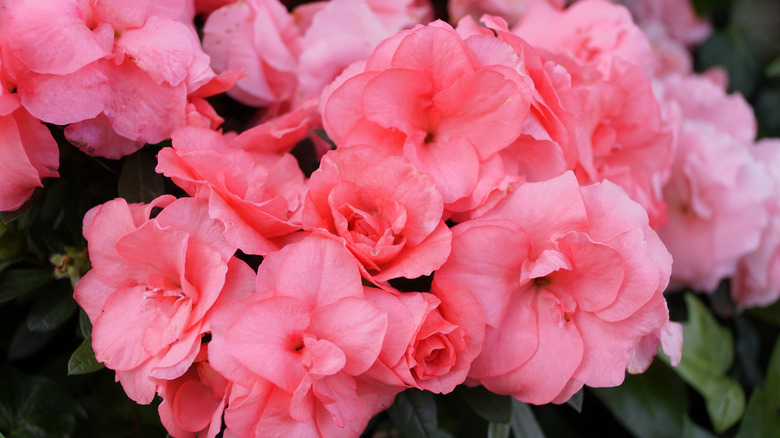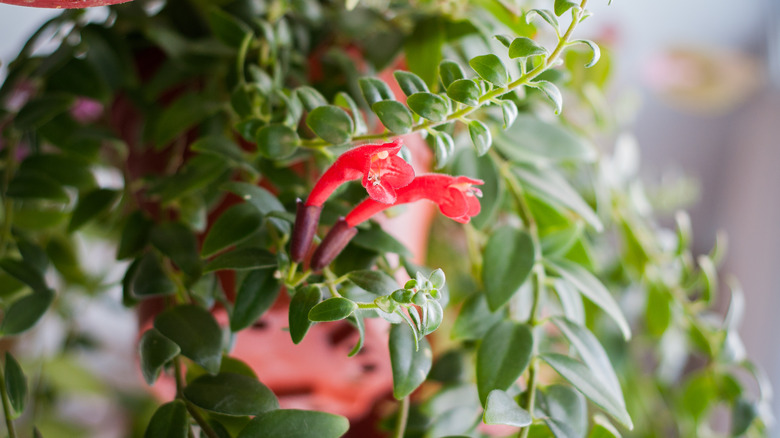15 Plants With Pink Flowers You Can Grow Indoors
Bright, showy, pink flowers don't need to stay in the garden. If you live in a colder state or you simply want more color inside your home, don't be afraid to grow some of your favorite pink flowers indoors. Typically garden-grown plants such as carnations, begonias, and calla lilies grow well in containers when you know how to meet their needs.
Depending on your indoor gardening experience, there are many pink-flowering varieties for you to choose from. Be sure to consider your schedule, the light your home receives, and the size of your space before you make a decision, as recommended by Millcreek Gardens. Certain plants such as anthurium and Christmas cacti need plenty of sunlight to survive indoors. Once you've made all the necessary considerations, you can plant any of these 15 indoor-friendly pink flowers to create a gorgeous garden feature inside your home that may flower throughout the year.
1. Calla lily
Calla lilies (Zantedeschia rehmannii) are a popular perennial in warmer regions that are often used in cutting gardens. However, if you live in a colder area, they can be successfully grown indoors. As per Longfield Gardens, calla lilies do well in containers where they will show off pink flowers for weeks. All you need to do is provide them with adequate sunlight and water them regularly.
Bloom Season: Early to late spring
USDA Growing Zone: 8 to 10
Growing Conditions: Bright to medium light
Soil Type: Well-draining
Size: 1 to 2 feet tall
2. Carnation
Carnations (Dianthus caryophyllus) are a part of a genus with more than 300 species, as explained by Monrovia. Each of these species has similar care instructions, yet they often look quite different from one another. Indoors, you can grow several of these Dianthus species in pink with little effort. Just make sure you place yours in a sunny window and water it about once per week.
Bloom Season: Spring and summer
USDA Growing Zone: 3 to 9
Growing Conditions: Full sun
Soil Type: Rich and well-draining
Size: 4 to 36 inches tall
3. Moth orchid
Moth orchids (Phalaenopsis spp.) are commonly grown indoors as they do well in east or west-facing windows, and they only need to be watered once per week, explains the University of Maryland Extension. These orchids produce gorgeous flowers on long stalks that can last months.
Bloom Season: Winter to spring
USDA Growing Zone: 11 to 12
Growing Conditions: Bright indirect light
Soil Type: Loose bark or another loose potting medium
Size: No larger than 3 ft tall
4. Kalanchoe
Kalanchoe (Kalanchoe blossfeldiana) can be identified by its green, scalloped leaves and clumps of small flowers. As told by Clemson Cooperative Extension, this succulent, native to Madagascar, is drought-tolerant and enjoys bright light with a little shade. In addition to pink, you can find these flowers in red, orange, white, and yellow.
Bloom Season: Early spring
USDA Growing Zone: 10 to 12
Growing Conditions: Bright, direct light
Soil Type: Well-aerated and well-drained
Size: 8 inches to 1 foot tall
5. Urn plant
Urn plants (Aechmea fasciata), sometimes called bromeliads, are one species of Aechmea among 255, according to North Carolina State Extension. This unique flowering plant does well as a house plant because it requires only some attention and it grows slowly. Even though Aechmea fasciata technically produces small blue, red, or purple flowers, its showy pink bracts are what the plant is known for.
Bloom Season: Year-round
USDA Growing Zone: 10 to 12
Growing Conditions: Indirect sunlight and light shade
Soil Type: Well-drained, loam, or sand
Size: 1 to 3 feet tall and wide
6. Flowering maple
Flowering maple (Abutilon 'Bella Pink') is a plant that may be grown in a container indoors or outdoors. Among maple-like leaves, this evergreen shrub produces pink, bell-shaped flowers, via Buchanan's Native Plants. Growing your own flowering maple is easy. Simply provide it with frequent waterings and a sunny window.
Bloom Season: Early spring to late winter
USDA Growing Zone: 10
Growing Conditions: Bright to medium light
Soil Type: Common potting medium
Size: 6 feet tall and wide, but much smaller when container-grown
7. Anthurium
Anthurium (Anthurium andraeanum), also called the flamingo flower, is well known for its large dark green leaves and its heart-shaped blossoms that flower year-round. This epiphytic plant does well in containers, however, it must be watered frequently, and it will need high humidity in the summer, says RHS.
Bloom Season: Year-round
USDA Growing Zone: 11 to 12
Growing Conditions: Bright to medium light
Soil Type: Well-drained loam or sand
Size: 4 to 20 inches tall and wide
8. African violet
African violets (Saintpaulia ionantha) are typically found with blue or purple flowers; however, you can buy cultivars that bloom in white, fuchsia, or pink, as per Missouri Botanical Garden. This beautiful plant is not suitable for beginner gardeners as African violets must be kept moist and require special conditions to bloom properly.
Bloom Season: Flowers freely
USDA Growing Zone: 11 to 12
Growing Conditions: Indirect medium to low light
Soil Type: Loose, highly organic potting medium
Size: 6 to 9 inches tall
9. Christmas cactus
The Christmas cactus (Schlumbergera russelliana) is another epiphytic plant that is typically grown indoors. House plant growers enjoy this succulent because it flowers during the holidays. Its pink flowers are unique with a double-flowered look, as shown by North Carolina State Extension. Christmas cacti should be watered every other week and kept in an indirectly sunny spot of your home.
Bloom Season: Fall and winter
USDA Growing Zone: 9 to 11
Growing Conditions: Bright light
Soil Type: Moist, well-draining
Size: 6 inches to 1 foot tall
10. Persian cyclamen
Persian cyclamen (Cyclamen persicum) blooms for about three months from winter to spring. They are loved for their fragrant, twisted petals that are most often pink, red, or light purple, according to the University of Wisconsin-Madison. Keep in mind that even when these plants are grown indoors, they are short-lived. During their life span, be sure to give your Persian cyclamen an east-facing window and high humidity.
Bloom Season: Winter and spring
USDA Growing Zone: 9 to 11
Growing Conditions: Shade to part shade
Soil Type: Loamy, moist, and well-draining
Size: 6 to 9 inches tall
11. Amaryllis
Amaryllis (Hippeastrum spp.) is grown indoors so it can bloom over the holidays. Though you'll most often see red amaryllis flowers, you can find them in shades of pink such as salmon, rose, and apricot, says the University of Minnesota. Only water amaryllis when the top 2 inches of soil are dry and allow it to receive just six hours of direct sunlight per day.
Bloom Season: May bloom at any time during the year
USDA Growing Zone: 9 to 11
Growing Conditions: Medium light and partial shade
Soil Type: Well-draining and organic
Size: 1 to 2 feet tall
12. Begonia
Begonias (Begonia spp.) do well in containers such as hanging planters. They can be identified from their attractive foliage and dainty flowers that may be pink, white, or red, as told by Clemson Cooperative Extension. Begonias require direct sunlight to flower, but you should watch them carefully for burns.
Bloom Season: Late spring and summer
USDA Growing Zone: 7 to 11 depending on the cultivar
Growing Conditions: Organic, moist, and well-draining
Soil Type: Partial shade to full sun
Size: Typically 8 to 24 inches tall, but varies by cultivar
13. Chinese hibiscus
Chinese hibiscus (Hibiscus rosa-sinensis) is also called tropical hibiscus or Hawaiian hibiscus. This plant produces giant 2 to 10-inch blossoms that last for just a single day. Despite its short-lived flowering period, this plant is quite beautiful as it features glossy foliage that stays green throughout the year when you provide it with moist conditions and plenty of sunlight, explains Smithsonian Gardens.
Bloom Season: Spring and summer
USDA Growing Zone: 9 to 12
Growing Conditions: Bright direct sunlight
Soil Type: Well-drained
Size: Up to 10 feet tall and 6 feet wide, but much smaller when container-grown
14. Cape primrose
Cape primrose (Streptocarpus ssp.) is known for its long blooming period and showy pink, blue, purple, or white flowers. A relative of African violets, this plant needs little sunlight and regular watering, according to Missouri Botanical Garden. With good care, your cape primrose will make for a wonderful container plant kept indoors.
Bloom Season: Flowers freely
USDA Growing Zone: 10 to 11
Growing Conditions: Low light and partial shade
Soil Type: Fertile, humus-rich, and well-draining, but moist
Size: 12 to 18 inches tall and wide
15. Lipstick plant
Lipstick plants (Aeschynanthus radicans) are named after their tubular flowers, which look like an open tube of pink, orange, or red lipstick. This tropical epiphyte needs frequent watering, some humidity, and bright indirect sunlight to survive, as explained by North Carolina State Extension.
Bloom Season: Fall, spring, and summer
USDA Growing Zone: 10 to 11
Growing Conditions: Medium to bright indirect light
Soil Type: Organic and well-draining
Size: Up to 3 feet tall
